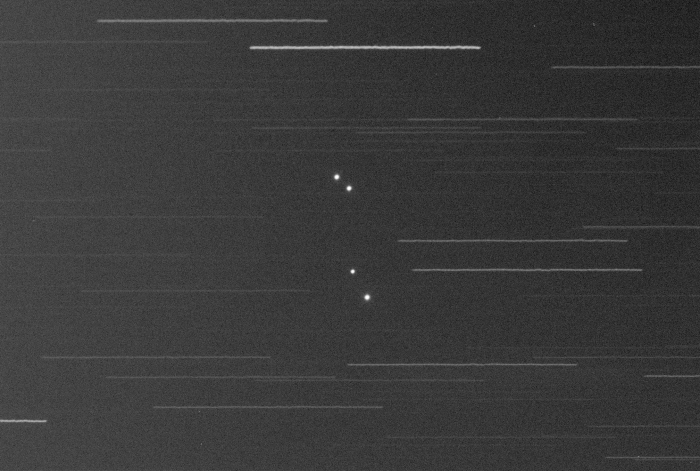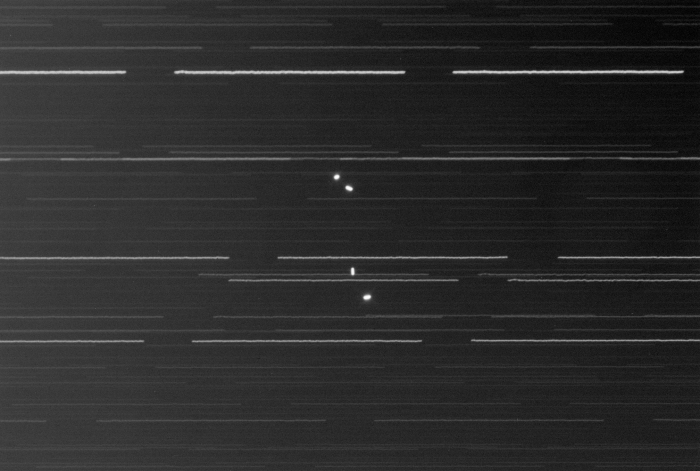
Roughly 500 geostationary satellites are currently placed in a static orbit (as viewed by a ground-based observer) about our planet at an
altitude ranging from 500 to 40,000 kilometers. The closest satellites orbitting the planet are believed to be spy satellites whereas most
distant are the geostationary group of satellites with an instrinsic magnitude of 11 or greater. As a result, due to their distance and faint
magnitude, geosats may be classified as the DSO's of the satellite world. At their high altitude not only can they virtually view the complete
globe below them but they also have the unique characteristic of having their orbital speed closely match the rotational speed of the earth
and, as such, give the impression to a ground-based observer of being stationary above the planet. These satellites have a wide range of
applications and functions and include remote sensing (Meteosat, GOES-East and GOES-West, GMS etc) and such telecommunication functions as
direct broadcast voice and video communications as well as live television coverage (Astra, Hot Bird, Telstar etc) by virtue of the fact they
can beam their signal from a "fixed" point in space relative to a ground source.
Note: The Astra fleet at 19.2° East is currently comprised of Astra 1KR, 1L, 1M and 2C and whose purpose is direct
to home TV, radio and interactive television. Its primary market is continental Europe ranging as far east as Greece and as far north as the
Scandinavian countries. Each satellite has a proposed lifetime of 15 years. The oldest of the four satellites is Astra 2C and which was launched
on June 16, 2001 from the Baikonur Cosmodrome in Kazakhstan using a Proton K rocket, weighs 3.635 tons and features 32 Ku-band transponders.
Astra 1KR was lunched on April 26, 2006 from Cape Canaveral, Florida, using an Atlas V rocket, weighs 4.332 tons and also features 32 Ku-band
transformers. Astra 1L was launched on November 4, 2007 from Kourou, French Guyana using an Ariane 5 ECA rocket, weighs 4.497 tons and features
29 Ku- and 2 Ka-band transponders. Finally, Astra 1M was launched on November 5, 2008 from the Baikonur Cosmodrome in Kazakhstan using a Proton
M rocket, weighs 5.320 tons and features 36 Ku-band transponders.
Note: The first image below represents a single one-minute exposure whereas the second image below is the sum of
the fifteen one-minute exposures captured and which reveals some very slight motion for the four Astra satellites during the approximate 20-minute
span and which quite often is characteristic of geosats (ex. due to inclination).
|
NORAD ID: 26853 (2C), 29055 (1KR), 31306 (1L), 33436 (1M), Common Name(s): Astra 2 C, Astra 1 KR, Astra 1 L, Astra 1 M, Int Code: 2001-025A 2006-012A, 2007-016A, 2008-057A Location: 19.2° East Perigee: 35,768.2 - 35,786.6 km Apogee: 35,802.5 - 35,819.3 km Inclination: 0.0 - 0.1° Period: 1,436.1 min Launch Dates: Jun 16, 2001 (2C), Apr 26, 2006 (1KR), May 04, 2007 (1L), Nov 05, 2008 (1M) Origin: Luxembourg |
 
|
Date: Nov 02, 2012 22:53 - 23:11 UT+2 Location: Athens, Greece Equipment: AP 305/f3.8 Riccardi-Honders AP 1200GTO GEM SBIG ST-10XME SBIG CFW10 SBIG LRGB filters Integrations:
Image Scale: 1.21" per pixel Temperatures:
Software: CCDSoft V5.00.201 CCDStack V1.6.0.5 Photoshop CS5 |